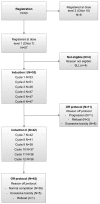Feasibility and efficacy of addition of individualized-dose lenalidomide to chlorambucil and rituximab as first-line treatment in elderly and FCR-unfit patients with advanced chronic lymphocytic leukemia
- PMID: 30115656
- PMCID: PMC6312018
- DOI: 10.3324/haematol.2018.193854
Feasibility and efficacy of addition of individualized-dose lenalidomide to chlorambucil and rituximab as first-line treatment in elderly and FCR-unfit patients with advanced chronic lymphocytic leukemia
Abstract
Lenalidomide has been proven to be effective but with a distinct and difficult to manage toxicity profile in the context of chronic lymphocytic leukemia, potentially hampering combination treatment with this drug. We conducted a phase 1-2 study to evaluate the efficacy and safety of six cycles of chlorambucil (7 mg/m2 daily), rituximab (375 mg/m2 cycle 1 and 500 mg/m2 cycles 2-6) and individually-dosed lenalidomide (escalated from 2.5 mg to 10 mg) (induction-I) in first-line treatment of patients with chronic lymphocytic leukemia unfit for treatment with fludarabine, cyclophosphamide and rituximab. This was followed by 6 months of 10 mg lenalidomide monotherapy (induction-II). Of 53 evaluable patients in phase 2 of the study, 47 (89%) completed induction-I and 36 (68%) completed induction-II. In an intention-to-treat analysis, the overall response rate was 83%. The median progression-free survival was 49 months, after a median follow-up time of 27 months. The 2- and 3-year progression-free survival rates were 58% and 54%, respectively. The corresponding rates for overall survival were 98% and 95%. No tumor lysis syndrome was observed, while tumor flair reaction occurred in five patients (9%, 1 grade 3). The most common hematologic toxicity was grade 3-4 neutropenia, which occurred in 73% of the patients. In conclusion, addition of lenalidomide to a chemotherapy backbone followed by a fixed duration of lenalidomide monotherapy resulted in high remission rates and progression-free survival rates, which seem comparable to those observed with novel drug combinations including novel CD20 monoclonal antibodies or kinase inhibitors. Although lenalidomide-specific toxicity remains a concern, an individualized dose-escalation schedule is feasible and results in an acceptable toxicity profile. EuraCT number: 2010-022294-34.
Copyright© 2019 Ferrata Storti Foundation.
Figures





References
-
- Goede V, Fischer K, Busch R, et al. Obinutuzumab plus chlorambucil in patients with CLL and coexisting conditions. N Eng J Med. 2014;370(12):1101–1110. - PubMed
-
- Hallek M. Chronic lymphocytic leukemia: 2017 update on diagnosis, risk stratification, and treatment. Am J Hematol. 2017;92(9):946–965. - PubMed
-
- Goede V, Fischer K, Engelke A, et al. Obinutuzumab as frontline treatment of chronic lymphocytic leukemia: updated results of the CLL11 study. Leukemia. 2015;29:16024. - PubMed
Publication types
MeSH terms
Substances
LinkOut - more resources
Full Text Sources
Other Literature Sources

